| Article ID | Journal | Published Year | Pages | File Type |
|---|---|---|---|---|
| 4954289 | Computer Communications | 2017 | 21 Pages |
Abstract
Classical wireless cellular networks configure semi-static values of handover decision parameters, which are usually been modified manually by the operator at a certain time interval post analyzing the network performance report. To reduce the operator's manual intervention, 3rd Generation Partnership Project (3GPP) proposed Self-Organizing Network (SON) concept for Handover (HO) decision parameters optimization for the LTE-Advanced (LTE-A) network. However, considering high-speed mobility requirements and ever-growing complexity from the contemporary LTE-A network, neither the classical manual approach nor the existing SON based approach from the prior-art will be able to meet the stringent HO performance goal set by the standard. In addition, unconventional handover algorithms and their decision parameters setting can affect user throughput, increases call drops and finally degrades the mobility performance of the overall LTE-A network. Therefore, in this paper, we propose a novel and efficient self-optimizing HO detection along with HO execution and decision parameter optimization algorithm which is named as Handover Detection Self-Organizing-HO Parameters (HD-SOHP) based on Reinforcement Learning (RL) concept. HD-SOHP improves the users' mobility performance by achieving effective session handovers thereby reducing call drop, HO failures and ping-pong at the cell level. Compared with the different SON based handover techniques as stated in Table 2, Table 3 and Table 4, HD-SOHP gives two times performance improvement with respect to call drop, handover failure and ping-pong for the users' moving with speed up to 120kmph.
Related Topics
Physical Sciences and Engineering
Computer Science
Computer Networks and Communications
Authors
Saptarshi Chaudhuri, Irfan Baig, Debabrata Das,
